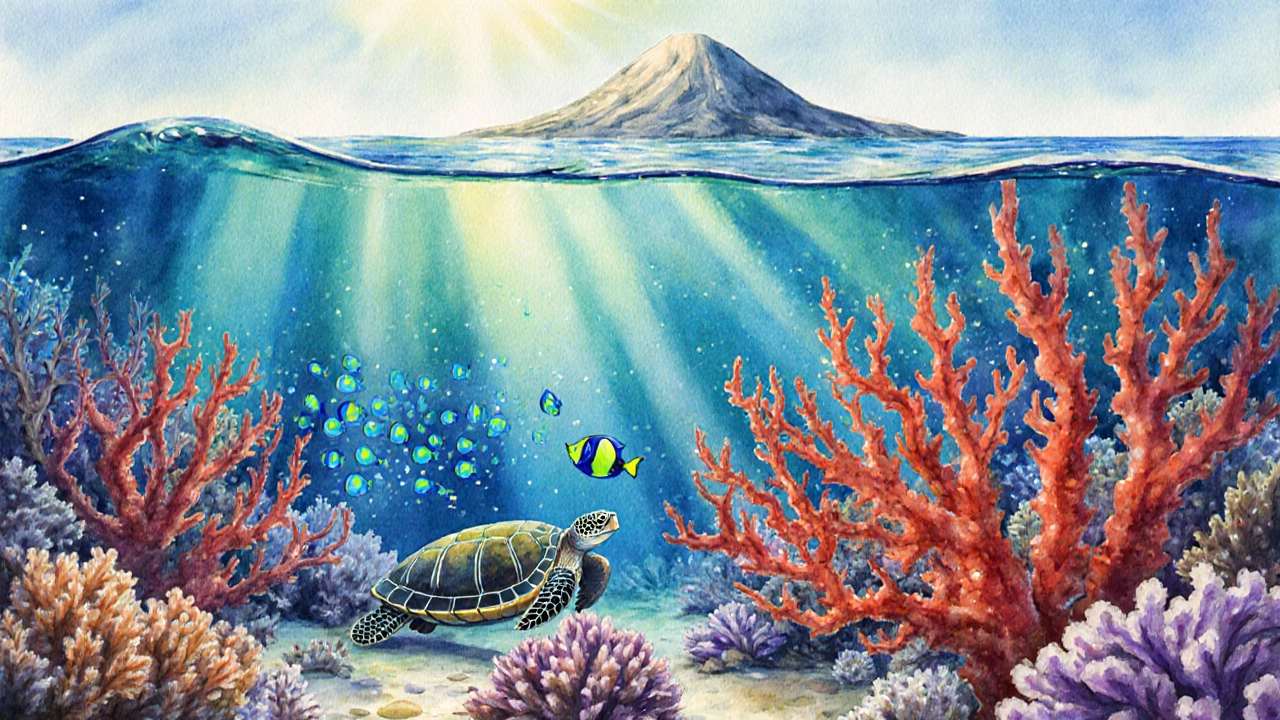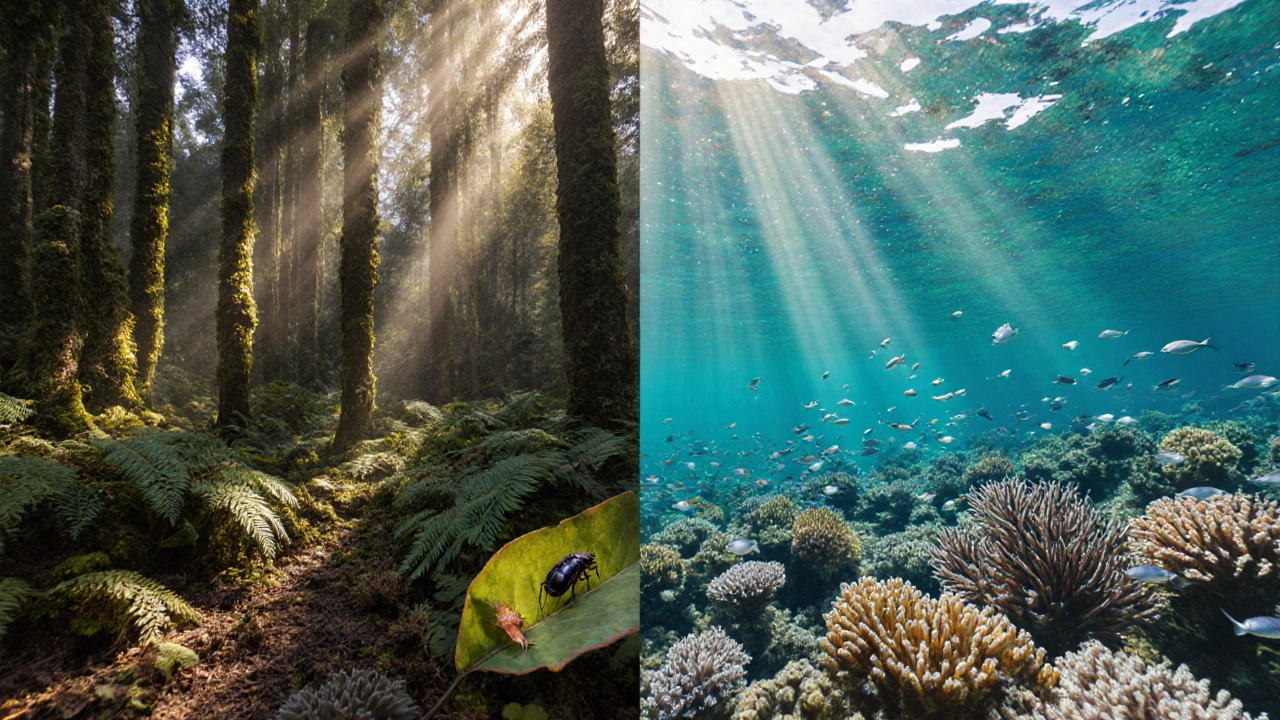Ecosystem Comparison Tool
Compare Ecosystem Types
Select a characteristic to see how terrestrial and aquatic ecosystems differ.
Terrestrial Ecosystems
Aquatic Ecosystems
When biologists talk about an Ecosystem is a community of living organisms interacting with the non‑living elements of their environment, they’re describing a massive, self‑regulating network of life. Understanding the two main ecosystem groups-terrestrial and aquatic-helps anyone from a student to a conservation volunteer see why a forest in New Zealand matters just as much as a coral reef off the Great Barrier.
What exactly is an ecosystem?
An ecosystem combines Biotic factor with all the living organisms-plants, animals, microbes-within a defined area and Abiotic factor such as water, temperature, sunlight, and soil chemistry. These pieces exchange energy and matter, creating cycles like nutrient recycling and food webs that keep the system stable over time.
The two main groups of ecosystems
Scientists classify all ecosystems into two broad groups based on where the dominant energy source and medium lie.
- Terrestrial ecosystem - land‑based environments where soil and air dominate the physical backdrop.
- Aquatic ecosystem - water‑based habitats, ranging from shallow ponds to deep oceans.
Both groups host a staggering variety of life, but they differ in climate drivers, typical organisms, and how energy moves through them.
Terrestrial ecosystems in detail
Land ecosystems are anchored by soil, which stores water, nutrients, and organic matter. The main energy input is sunlight hitting plants, which then fuel herbivores and top predators. Common terrestrial biomes include:
- Forest - dense tree cover, high canopy complexity, and rich Food web that links insects, birds, mammals, and decomposers.
- Grassland - open spaces dominated by grasses; fire and grazing shape community structure.
- Desert - extreme temperature swings and minimal water; organisms adapt with water‑storage tissues and nocturnal habits.
Because soil retains moisture, terrestrial ecosystems often experience seasonal droughts or floods that drive plant phenology and animal migrations.
Aquatic ecosystems in detail
Water is the defining medium for aquatic ecosystems. Energy can come from sunlight (in shallow zones) or from chemical gradients (deep‑sea vents). Major aquatic categories are:
- Freshwater lake - closed basins with stratified temperature layers; support fish, amphibians, and plankton.
- River and stream - flowing water creates riffles and pools, influencing oxygen levels and sediment transport.
- Coral reef - warm, shallow marine habitats built by calcium‑carbonate skeletons of tiny animals; host some of the highest biodiversity on the planet.
- Open ocean - vast, low‑nutrient areas where productivity hinges on upwelling zones that bring deep, nutrient‑rich water to the surface.
Aquatic systems tend to have higher primary productivity per unit area than most terrestrial ones, thanks to the efficient diffusion of nutrients in water.
Side‑by‑side comparison
| Aspect | Terrestrial | Aquatic |
|---|---|---|
| Dominant medium | Soil and air | Water (fresh or salt) |
| Primary energy source | Sunlight captured by plants | Sunlight (phytoplankton) or chemical energy (chemosynthesis) |
| Typical biomes | Forest, grassland, desert, tundra | Freshwater lake, river, coral reef, open ocean |
| Average primary productivity | ~0.5-2.0 g C m⁻² day⁻¹ | ~1.5-4.0 g C m⁻² day⁻¹ (coastal) or <0.1 g C m⁻² day⁻¹ (open ocean) |
| Key adaptation challenges | Water retention, temperature extremes | Osmoregulation, pressure, light attenuation |
The table highlights why conservation strategies differ: protecting a forest often means managing fire regimes and invasive plants, while safeguarding a reef focuses on water quality and over‑fishing control.

Why the two‑group view matters for conservation
Grouping ecosystems simplifies policy. International frameworks like the Convention on Biological Diversity use the terrestrial/aquatic split to set separate targets for land‑based protected areas and marine reserves. It also helps educators build curricula-students can first grasp the basics of one group before tackling the other.
Moreover, many threats blur the line. Climate‑induced sea‑level rise turns coastal wetlands from terrestrial to aquatic, demanding integrated management plans that respect both categories.
Common misconceptions to avoid
- All forests are the same. In reality, a temperate rainforest differs dramatically from a boreal conifer forest in species composition and fire sensitivity.
- Ocean ecosystems are only about fish. Coral reefs, kelp forests, and deep‑sea vents each host unique communities that don’t rely on fish as the keystone.
- Freshwater habitats are “less important” than oceans. Freshwater systems supply drinking water, irrigation, and support a disproportionate share of global biodiversity.
Quick checklist for anyone studying ecosystems
- Identify the dominant medium: soil/air or water.
- List the main abiotic factors (temperature, moisture, light, nutrients).
- Map out the primary producers and at least one consumer level.
- Note any human pressures (deforestation, pollution, over‑fishing).
- Connect the ecosystem to a larger biome or ecoregion.
Follow these steps, and you’ll quickly see whether you’re looking at a terrestrial or aquatic system-and what that means for its health.
What defines a terrestrial ecosystem?
A terrestrial ecosystem is land‑based, with soil and air as the primary physical components. Plants convert sunlight into energy, forming the base of a food web that includes herbivores, predators, and decomposers.

How does an aquatic ecosystem differ from a terrestrial one?
Aquatic ecosystems are water‑based, so organisms must regulate salt and pressure. Energy can come from sunlight (phytoplankton) or chemicals (chemosynthesis). Nutrient diffusion is faster in water, often leading to higher primary productivity.
Can an ecosystem belong to both groups?
Transitional zones like mangroves or tidal marshes exhibit characteristics of both. They’re technically classified as coastal aquatic ecosystems, but their tree roots and soil layers give them strong terrestrial traits.
Why is primary productivity often higher in aquatic systems?
Water efficiently transports nutrients and gases, allowing photosynthetic organisms like phytoplankton to grow rapidly. In shallow, sunlit waters, this can outpace the growth rates of most land plants.
What are the biggest threats to terrestrial ecosystems?
Deforestation, habitat fragmentation, invasive species, and climate‑induced fire regimes are the top drivers of biodiversity loss on land.
How can individuals help protect aquatic ecosystems?
Reduce plastic use, support sustainable seafood choices, and participate in local water‑cleanup events. Policies that limit runoff and over‑fishing also make a huge difference.





